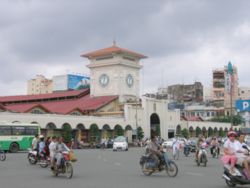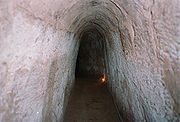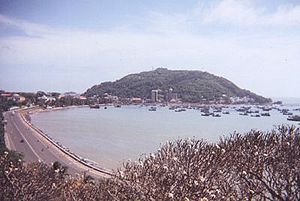
 Miss Saigon
Miss Saigon
While everyone knows these days that Vietnam’s capital is called Ho Chi Minh City, it’s a harder to romanticize about a man with the goatee than a melodic image of "Miss Saigon" in her ao dai and conical hat. As all visitors are aware, Ho Chi Minh City is a town of sharp contrasts and conflicts. It is historically charming yet developing rapidly; graceful yet sometimes garish; a city where friendliness abounds but you can be easily fooled. It is a fascinating metropolis of many different flavors – all of which must be experienced. The best aspect is that in the town itself, most attractions are within walking distance to each other.
Five things you have to do:

 Benh Thanh Market
Benh Thanh Market
• Chow in Cholon Cholon is the most hectic part of Saigon. Otherwise known as Chinatown, Cholon is the economic heartbeat of the city where opium dens, prostitutes and gambling once converged (although these days, Saigon’s Fifth District is a deeper shade of red). It’s a place to sup on soups in the street and soak up the lively atmosphere. Also, the absolute must-see of Cholon is Benh Thanh Market, a bazaar that can be as bizarre as it is exciting to the foreign eye. Watch locals haggle over the price of live chickens and rice, while you consider buying a funnel-shaped rice hat (don’t be such a cliché) and postcards.
• Visit the Cu Chi Tunnel Complex. OK, so this isn’t exactly in town, but it’s only a two-hour drive from the city and well worth the distance. The tunnels comprise an elaborate underground maze created by the Viet Cong during the war. Here, soldiers worked, ate, planned, lived their lives entirely in a space barely a meter high and no more than 80 centimeters wide. Visitors can crawl into the tunnels to get a feel of what it would’ve been like to exist in this surreal subterranean labyrinth.

 Part of the tunnel complex
Part of the tunnel complex
Tours through and around the tunnel sections are open to the public and are guided – a necessary element due to existing booby traps and these, which are also on display for foreigners to see, consist mostly of gruesome-looking contraptions with long metal spikes. Beyond the tunnels, tourists have the opportunity to fire an AK-47 rifle; a rather authentic experience, if not a little unsettling. The ever-friendly guides are very willing to answer questions – all guides are connected to the tunnel complex in some way, many were actually born in there. Above-ground, the shady woodlands provide a nice reprieve from the city’s hustle and bustle.
• Manage some Museum Fatigue Like every capital city, Saigon has its fair share of museums and galleries. The first on the list should be the War Remnants Museum, formally named "the Museum of Chinese and American War Crimes". While the latter name is straight to the point, it (unsurprisingly) turned away the tourists and was thus revised to its current, more euphemistic title. However, priceless signage such as the label which reads: "Some Pictures of US Imperialist Aggressive War Crimes in Vietnam” can still be found inside.
Next on the list to see (before that museum fatigue starts to kick in) is the Reunification Palace. Ever since Communist tanks burst through the gates of the Presidential Palace on April 30, 1975, the building has become a symbol for the South Vietnamese government. Renowned for its striking retro design, the palace is an astonishing display of artistic talent from one of the city’s Parisian-trained architects, Vgo Viet Thu. The war room, basement tunnels and quick-escape helipad on the back terrace also make for some interesting features.

 Vung Tau
Vung Tau
• Visit Vung Tau. Once the premier beach retreat of Vietnam, Vung Tau is a long-standing port that still attracts many visitors with its sandy shores and tranquil waters – albeit they’re not as pristine as the old days. Only 75 miles from Saigon, the peninsula of Vung Tau offers five beaches, each with unique qualities. Bai Trouc is well-developed and has an array of restaurants, shops and hotels, while Vong Nguyen is popular among surfers. Bai Dua is the quietest beach and located only a mile from the city center while the nearby Bai Dau at Lon Mountain is also less crowded. The longest stretch of beach can be found at Bai Sau. If you’re interested in a beachside sojourn, see these hotels in Vung Tau.
• Temples and tombs. One of Saigon’s foremost places of worship is the Giac Lam Pagoda which resides near Dam Sen Park. Its architecture dates back from the 19th century Nguyen Dynasty (it is the oldest Pagoda standing in the country), and there are over 150 statues within the compound. At the entrance, decorous, austere tombs sit next to the looming Goddess of Mercy, Quan Thew Am Bo Tat. Another classic sightseeing must is the Notre Dame Cathedral whose towers once dominated the city’s skyline. For those who worship a different kind of god (fashion), the cathedral is in close proximity to Saigon’s premiere shopping district, Dong Khoi Street, the Vietnamese equivalent of New York’s 5th Avenue. It is located in one of the best parts of Ho Chi Minh.